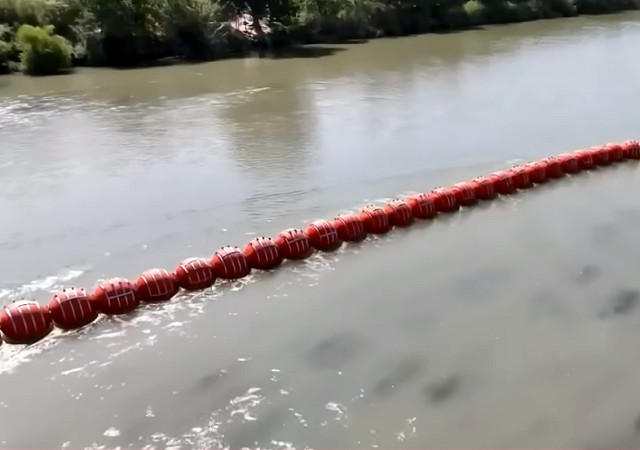Border Crisis: 5th Circuit Allows Texas to Keep Buoys for Now
The court granted the en banc hearing, which will consist of all the appellate court’s judges. It is scheduled for May 2024.

The entire 5th Circuit Court of Appeals ruled that Texas could keep its border barrier as the court rehearsed the case against court rulings that declared the buoys illegal.
“Enclosed is the court’s order filed this date directing this case be reheard en banc with oral argument,” wrote Angelique Tardie, the deputy clerk. “Under Fifth Circuit Local Rule 41.3 this order vacates the previous opinion and judgment of this court and stays the mandate.”
President Joe Biden’s administration has been dragging Texas through the courts to force the state to remove the barriers.
In September, Judge David Alan Ezra of the U.S. District Court Western District of Texas – Austin Division ordered Texas to remove the buoys from the Rio Grande in a preliminary injunction.
Ezra gave Texas until September 15 to remove the barrier.
Texas appealed.
The 5th Circuit panel temporarily halted Ezra’s order.
In December, a split three-judge panel of the 5th Circuit, 2-1, sided with Ezra‘s ruling to remove the buoys.
Texas Gov. Greg Abbott and Texas Attorney General Ken Paxton sought an en banc hearing from the 5th Circuit.
An en banc hearing consists of all the appellate court’s judges.
Texas got lucky since the hearings are rare. However, courts will usually grant the consideration if they “believe that the matters are especially complex or important.”
“We request that the parties forward 22 copies of their previously filed merits briefs, reply briefs, supplemental briefs, and record excerpts, for the use of the en banc court,” continued Tardie. “As you did previously, we request that all copies be spirally bound. These additional copies are due in the Clerk’s Office by January 31, 2024.”
The 5th Circuit gave the appellants until February 16 to file an en banc brief.
The en banc brief is due on March 18.
The court will hear the case in May.
 DONATE
DONATE
Donations tax deductible
to the full extent allowed by law.








Comments
How magnanimous of the Fifth Circuit!
If I were the Texas administration, I’d keep the buoys there regardless of what any court says. What court has the equipment to move them, anyway?
Exactly. The states are SUPPOSED to have rights, and should be able to protect themselves and their citizens, especially when the federal government is refusing to fulfill its responsibilities.
Secede
No. Stand and fight.
Secede from the cabal. Enough of deep state lawfare and corrupt judges
Secession is neither practical nor possible, unless you’re ready to herd the opposition into railcars and ship them out of the state.
A national divorce guarantees a civil conflict. Internecine warfare, red on blue, neighbor against neighbor, house-to-house fighting. There’s no way that ends well.
Stand and fight, or roll over and concede. Unfortunately, the American people aren’t willing to pull themselves away from their cell phones and streaming services because that might be uncomfortable. And we like being comfortable. Until we aren’t.
Just buoys? Add a few “welcome surprise” bouncing Betty’s.
TX is already under fire because a couple of illegal aliens drowned trying to cross the buoy line. It’s a barrier, not a fortification — as long as it is backed up by Border Patrol doing their job, and the state government willing to prosecute and return invaders to their home territory
The float barrier is dangerous? The frickin’ river is dangerous! The point of barriers (e.g., a wall) are to make a crossing more difficult. Often, they’re purposefully made more dangerous (e.g., minefields, barbed wire) to dissuade attempts at crossing.
BTW, there’s a local lake where the swim area is bounded by floats. Nobody has found them dangerous, possibly because nobody bothers to try to cross them.
“The float barrier is dangerous?”
Who says?
“For now”
GTH
Texas agrees to remove buoys February 31st
Buoys now identify as guoyls…
No State shall, without the Consent of Congress, lay any Duty of Tonnage, keep Troops, or Ships of War in time of Peace, enter into any Agreement or Compact with another State, or with a foreign Power, or engage in War, unless actually invaded, …
So, the Texas governor has declared an invasion. And taken steps to repel it. Right there in the Constitution. POTUS says it’s about immigration. Seems it’s apolitical question that doesn’t belong anywhere but the Supreme Court. Period. And if I were them I’d tell the two executives to work it out.
To work it out?
Time for “words” has passed
We are under an invasion of millions upon millions
I have a foolish question. Is there a distinction between the border of Texas and the border of the United States? Could one argue that, and say that the border of Texas lies inside the border of the United States; that is, if the barrier is built say, one yard inside the border between Mexico and the U.S. that it is in Texas, and thus within the authority and control of Texas. I note that California has control of its interstate borders and stops every vehicle (or used to) to inspect for fruits being brought into the state.
Art. I, sec 10 of the Constitution authorizes inspections by the States at their borders. The problem in Texas is not just that the federal government is claiming to have jurisdiction over a national border, but also that is has jurisdiction over the non-citizens trying to cross it. Because of the latter consideration, the federal government likely has the authority to dictate what barriers may be placed to control the entry of those people over whom it has jurisdiction as border-crossers. They’re people, not goods. At least, that’s a potential argument.
It’s not a crisis. A crisis is sudden, often unexpected. It’s a calamity, both engineered and sustained.